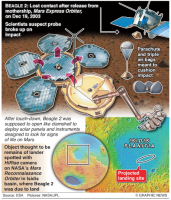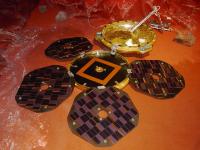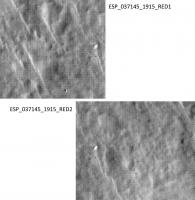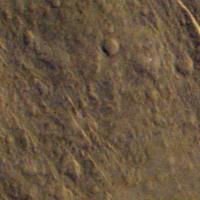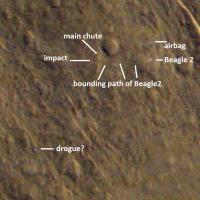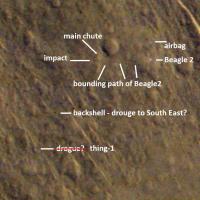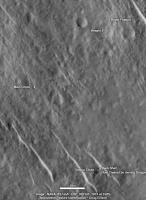Printable Version of Topic
Click here to view this topic in its original format
Unmanned Spaceflight.com _ Mars Express & Beagle 2 _ Beagle 2 found by MRO/HIRISE.
Posted by: xflare Jan 12 2015, 10:30 PM
Friday 16th January
http://www.theguardian.com/science/2015/jan/12/beagle-2-mars-lander-remains-red-planet?CMP=share_btn_tw
The Beagle 2 lander was supposed to touch down on Christmas day in 2003, but after it was released from its mothership, Mars Express, the dustbin-lid-sized craft was never heard from again.
But Beagle 2’s final resting place may finally have been discovered. Scientists operating the HiRise camera on Nasa’s Mars Reconnaissance Orbiter (MRO) will take part in a press conference this Friday to announce “an update” on the ill-fated mission.
Posted by: ngunn Jan 12 2015, 11:34 PM
Well spotted xflare. How did the Guardian find that? (I suspect an inside job.) It's always nice when the media are well connected science wise.
Posted by: elakdawalla Jan 13 2015, 02:53 AM
I am feeling extremely grouchy about the fact that the Guardian seems to have received a press release that I haven't. Either that, or they got something under embargo and broke the embargo. (I don't get embargoed press releases.) Has anybody seen the original press release online?
Posted by: Explorer1 Jan 13 2015, 04:15 AM
A tad more info from a Leicester article:
http://www.leicestermercury.co.uk/Beagle-2-University-Leicester-calls-media/story-25842553-detail/story.html
A tad...
Posted by: vikingmars Jan 13 2015, 08:01 AM
Thanks so much Xflare and Explorer1 for those much interesting news ! ![]()
Posted by: vikingmars Jan 13 2015, 08:20 AM
A found Beagle 2 Lander on Mars would be a much-deserved tribute given post mortem to Dr Pillinger.
He fought all he could to raise finance, test equipments, be on schedule, etc... and was not helped much by ESA which had to cope on its side with its own strict budgetary and management rules : see the official report issued by the House of Commons on November 2004 (here below) and especially the statement on its page 25, item # 49 : "According to the Chief Engineer of Beagle 2, Dr Clemmet, “The technical assistance received from ESA was quite restricted”. The Astrium project manager for Beagle 2, Mr Kirk, said that whilst those at ESA with whom he dealt were helpful and enthusiastic, “senior managers with one exception were always reticent. Their life would have been much easier if Beagle 2 had disappeared from MEx [Mars Express] much earlier than it did”." Beagle2_Government_support_2005_711.pdf ( 840.75K )
: 33739
Beagle2_Government_support_2005_711.pdf ( 840.75K )
: 33739
Thanks so much Dr. Pillinger for your enthusiasm for space exploration. We miss you ! ![]()
Posted by: Ian R Jan 15 2015, 12:16 AM
Yes, as exciting as this news may be, I still feel a tinge of sadness that Dr. Pillinger didn't live to set eyes on Beagle again (intact or otherwise)
Posted by: Decepticon Jan 15 2015, 02:38 AM
I will be shocked if it looks fully deployed.
Posted by: tolis Jan 15 2015, 03:04 PM
Let's see the evidence fist. I'll be sorely disappointed if this is just another
interesting collection of pixels like the previous "finds":
http://www.newscientist.com/articleimages/dn8494/2-wreckage-of-beagle-2-found-on-mars.html
I would expect to see more than that to clinch the case.
Tolis.
Posted by: Phil Stooke Jan 15 2015, 03:31 PM
The HiRISE people would not be involved if that's all it is.
Phil
Posted by: Floyd Jan 15 2015, 11:31 PM
Anyone have a link for the press conference?
Posted by: PaulH51 Jan 16 2015, 09:15 AM
You can watch the press conference LIVE on the Telegraph website in 45 minutes...
10am UK Time
http://www.telegraph.co.uk/news/science/space/11349858/Beagle-2-has-vanishing-probe-finally-been-found-LIVE.html
Posted by: ynyralmaen Jan 16 2015, 10:02 AM
Images now on BBC News website http://www.bbc.co.uk/news/science-environment-30784886?ns_mchannel=social&ns_campaign=bbc_breaking&ns_source=twitter&ns_linkname=news_central:
Posted by: ynyralmaen Jan 16 2015, 10:04 AM
Landed successfully, but only partially deployed, in which case the antenna probably wasn't uncovered. So close...
Posted by: kenny Jan 16 2015, 10:32 AM
UK Space Agency press announcement.
The images of Beagle, parachute and shell are in the video, which also shows animated images taken at different times, showing sun glint on metal.
https://www.gov.uk/government/news/uk-led-beagle-2-lander-found-on-mars
There is additional photo analysis on the BBC News site at the moment.
Posted by: xflare Jan 16 2015, 01:31 PM
And the HiRISE release http://www.uahirise.org/ESP_039308_1915
Posted by: pgrindrod Jan 16 2015, 01:35 PM
In case anybody can do anything good with them, I made a stereo HiRISE digital terrain model of the possible Beagle 2 site.
Snapshot (with candidate locations marked):
Full-resolution DTM and orthoimage geotiffs: https://www.dropbox.com/s/hh2xxuzhq90k6fs/Beagle2_HiRISE_DTM.zip?dl=0 (500 mb .zip)
It’s not of a very high quality because of a slightly dusty observation (I think, so low contrast for stereo matching), so there isn't really too much topographic detail in it up close.
From HiRISE stereo overlap (not proper pair, hence narrow)http://hirise.lpl.arizona.edu/ESP_030908_1915 and http://www.uahirise.org/ESP_037145_1915
Posted by: robspace54b Jan 16 2015, 01:59 PM
From the tiny images released today (16 Jan 2015) it does appear that only two of the solar panels deployed. The UHF antenna was a strip antenna and mounted on the underside of the s/c lid. If the last two solar panels panels did not deploy, then antenna would be totally covered. The info graphic I posted shows solar cells on the lid itself, which is not correct.
Posted by: robspace54b Jan 16 2015, 02:11 PM
Here are a couple more Beagle2 photos showing the UHF antenna (yellow square)
Posted by: djellison Jan 16 2015, 04:00 PM
Long before UMSF, there was a Beagle 2 Yahoo group I formed - just as a clearing house for info about a mission that was to be controlled just a few miles from where I lived at the time.
Frankly - MER was barely on my radar. When we never heard from Beagle...I was so disappointed - gutted beyond words. I'd even popped a good luck Christmas card under the door of Mission Control the night of landing.
To now know that it made it all the way to the ground is just astonishing. I was skeptical it had made it that far - especially with the absence of a parachute in MOC imagery ( turns out a MOC image in '04 was right over that spot...but the downlink got corrupted )
Without Beagle - there would have been no UMSF, and I wouldn't have ended up where I am today.
Wherever you are, Prof Pillinger..... thank you. You can be damned proud of what Britain did back in 2003.
Posted by: Ian R Jan 16 2015, 05:29 PM
Very well said, Doug.
Posted by: dvandorn Jan 16 2015, 05:30 PM
I would just like to express my mix of emotions, here. Extreme wonder and pride that the little Beagle that could, actually did. Intense frustration that a single petal deploy failure led to loss of mission. And deep and profound sadness that Dr. Pillinger did not live to see this day.
At least one thing that has changed my life came of it, even if the mission failed -- that it led to Doug creating this wonderful home-away-from-home for myself and all of my good friends here at UMSF.
Godspeed, Beagle 2.
-the other Doug
Posted by: robspace54b Jan 16 2015, 06:27 PM
Frankly - MER was barely on my radar. When we never heard from Beagle...I was so disappointed - gutted beyond words. I'd even popped a good luck Christmas card under the door of Mission Control the night of landing.
To now know that it made it all the way to the ground is just astonishing. I was skeptical it had made it that far - especially with the absence of a parachute in MOC imagery ( turns out a MOC image in '04 was right over that spot...but the downlink got corrupted )
Without Beagle - there would have been no UMSF, and I wouldn't have ended up where I am today.
Wherever you are, Prof Pillinger..... thank you. You can be damned proud of what Britain did back in 2003.
Hear, hear! Bravo for the brave souls who work so hard on these projects and as my friend put (for he is in the industry): "One failure and we close the lab."
Posted by: nprev Jan 16 2015, 06:35 PM
Deeply gratifying to see it on the surface. Also, of course, important beyond words for the future to see what worked and what didn't; that's how we learn and move forward.
Well done, Beagle 2 team, and well done, HiRISE team!!! ![]()
Posted by: pgrindrod Jan 16 2015, 06:44 PM
I wasn't involved in Beagle 2, but I was doing my PhD in the UK at the time, and watched my friend lose their job on Christmas day. So for that, and many other reasons, today has been good.
So, I've always wondered if this trick could actually be useful for anything...I think that the left-most object might fall in an overlap between HiRISE CCDs. Could the overlap be used for anything? Noise reduction? As an extra image for super-resolution (so 4 instead of 3)?
My (badly-calibrated, hence checker-board effect) non map-projected rush job of RED1 and RED2 of http://www.uahirise.org/ESP_037145_1915 as an example. The individual CCD images are in the http://hirise-pds.lpl.arizona.edu/PDS/EDR/ESP/ORB_037100_037199/ESP_037145_1915/products page.
EDIT: I've stuck all my context images up http://www.petergrindrod.net/archives/1359in case anybody wants to use them for talks etc.
Posted by: djellison Jan 16 2015, 07:18 PM
So if we've got it on R1 and R2 from 037145, one red from another observation, plus the three colors ( IR, R and bG ) from the color catch... we sort of have 6 images of it.
Posted by: mcaplinger Jan 16 2015, 08:43 PM
Is there any MOC coverage of this spot before the Beagle 2 landing? If it's close to the center of the ellipse I'd think there would be, and it would be useful to prove that the features are new.
Posted by: djellison Jan 16 2015, 09:18 PM
I don't think so.... if the Google Earth MOC layer is exhaustive and the ASU Global data search is similar exhaustive - it's definitely a no. http://viewer.mars.asu.edu/planetview/inst/moc/R1300632#P=R1300632&T=2 got close - but http://viewer.mars.asu.edu/planetview/inst/moc/R2100301#P=R2100301&T=2 is the only MOC NA image over the site - that that's corrupt and 9 months post landing
Posted by: xflare Jan 16 2015, 09:33 PM
There is also a white spot above the location of Beagle 2...any thoughts on what that might have been?
Posted by: elakdawalla Jan 16 2015, 09:42 PM
I was wondering about that, too. It's only really visible in the most recent image.
Also, my eye wants me to believe that there's something flapping around near the location of the backshell. I'm curious to hear others' opinions.
Posted by: PDP8E Jan 16 2015, 11:17 PM
does anyone have the Mars long/lat of Beagle2?
I want to get HiView up and running tonight when I get home
Thanks
Posted by: djellison Jan 16 2015, 11:17 PM
That'll be the drogue chute flapping about - something like 1.5m across
Lat long - 90.4295E 11.5265N
Posted by: J.J. Jan 17 2015, 01:02 AM
Though definitely bittersweet, I consider this more of a triumph than a loss: of the MRO team for finding it, and most of all of Beagle 2 just making it to the surface. When you think of the dire alternatives, that it made it down in one piece is nothing less than remarkable. Thanks to everyone who was involved. ![]()
Posted by: eoincampbell Jan 17 2015, 04:25 AM
Absolute triumph to see, thanks Prof. Pillinger and the team who must feel so proud... ![]()
Posted by: ynyralmaen Jan 17 2015, 12:46 PM
Althought it's most obvious in the latest image, there is a bright point at that same location in all three images; down to just 1-2 pixels though. Maybe it's one of the three airbags, and we're seeing a fold in the material?
Posted by: Phil Stooke Jan 17 2015, 03:37 PM
Doug: Beagle 2 location ---- Lat long - 90.4295E 11.5265N
try Long Lat - 90.4295E 11.5265N instead. You don't want to end up at 90.4 degrees north.
(well, he does add E and N... it's just the order I'm noting)
Phil
Posted by: tim53 Jan 17 2015, 05:03 PM
I looked last month, and unfortunately there isn't another one.
-Tim.
Posted by: tim53 Jan 17 2015, 05:25 PM
Also, my eye wants me to believe that there's something flapping around near the location of the backshell. I'm curious to hear others' opinions.
Doug and I were thinking that this might be the inside of the heat shield. It's even brighter in a new image just acquired by HiRISE, but it covers ~4 pixels (2x2), so it's about the right size.
-Tim.
Posted by: Phil Stooke Jan 17 2015, 09:09 PM
Looking at the details. The landing site is about 5 km from the middle of the post-landing tracking ellipse, but about 30 km from the middle of the pre-landing target ellipse. Some reports confuse the two. It was not 5 km off target.
Phil
Posted by: tim53 Jan 18 2015, 02:53 AM
Phil
I'm not sure I understand what you're saying. Since there was no communication with the orbiter after release, the nav ellipse must have been predicted at that time. I would think that the target ellipse was the plan before encountering Mars, maybe even before launch.
-Tim.
Posted by: PDP8E Jan 18 2015, 02:58 AM
Here is a 1st attempt at the color '39308' HiRise image, it is 3x. (The others are 30908 and 37145)
I have yet to collapse them all into one image, but that is a chore for another night.
The bright object to the north is most likely an airbag?
The three gas bags protecting Beagle were supposed to be 'ejected' away from Beagle after landing
Where are the other two? (covered in dirty dust and looking like surrounding ground? )
I am a little disappointed by the greenish tinges, but my program did the best it could (it's optimized for grayscales)
The 'parachute' is in this image at the southwest. The backshell may the one of the dark objects to the west or south of the 'parachute'? EDIT: the backshell was ejected with the dogue chute .. which remains to be imaged??
These objects are really small.
Congratulations to the Beagle Team for what looks like a good EDL and the MRO team for a great observatory in orbit around another planet (wow)
.... more later ...
Posted by: PDP8E Jan 18 2015, 04:23 AM
Beagle 2 came down on two parachutes the drogue that did the initial slowdown and ejected the backshell and then the main chute that brought it down to the ground and then was cut away on landing. So the main chute should be 'near' the lander, and the drogue further away. After looking at this image I would like to postulate the position of the 'main' chute and the bounding, rolling path of Beagle 2. (of course ... as my wife reminds me almost weekly... I could be wrong...) ![]()
Posted by: brellis Jan 18 2015, 05:11 AM
Communication was lost after Beagle separated, but it may have actually landed softly enough and deployed solar panels. Could that mean it took in some data? If it landed intact, and some day we got a robot or astronaut to recover the vessel, would it be possible to retrieve any such data from its hard drive or flash drive? Granted, the harsh conditions would degrade anything sitting around for years and years but it's interesting to consider...
In general once our robotic craft lose energy and conk out, could their hard drives or flash drives theoretically be retrieved like black boxes on earthly aircraft?
Posted by: Phil Stooke Jan 18 2015, 04:10 PM
"I'm not sure I understand what you're saying. Since there was no communication with the orbiter after release, the nav ellipse must have been predicted at that time. I would think that the target ellipse was the plan before encountering Mars, maybe even before launch.
-Tim."
You're right about both ellipses. The pre-landing target was the pre-launch target, as you say. But the final navigation solution leads to a much smaller ellipse when all the numbers are in (post-landing), giving you a smaller area to search with orbital cameras. The final version of the target ellipse was 174 by 106 km (Bridges et al. paper in 2003). The navigation solution was an ellipse 57 by 7.6 km across (Sims, 2004, Beagle 2 Mission Report).
The University of Leicester and the UK Space Agency both said this correctly. The BBC report is the one which says it was 5 km from the middle of the target ellipse - that's what I'm suggesting is misleading.
Phil
Posted by: mcgyver Jan 19 2015, 02:40 PM
I read in an article that one "lesson learnt", already being adopted in upcoming Exomars mission, is the lander to continuously send data to orbiter during EDL.
I think an additional lesson learnt is "don't cover the only one antenna by 4 plates", as one single failure out of 4 will compromise whole mission. Maybe a "contingency omnidirectional low power autonomous-battery external antenna" will become a standard in all next landers?
I am curious: why did it take so long to find Beagle2 if it is within the planned landing ellipse? Is this the first ever shot HIRISE image of the area?
This is weird, I was not aware of it.
Looking for and EDL animation I found this also weird video; guess made by who?
http://youtu.be/YjNyweyGwHQ
Airbags do not even appear in this video... Beagle is quite crashing rather than landing!
A better, official video from internet archive:
http://web.archive.org/web/20071006015240/http://video.beagle2.com/Descent/descent_a_640x368.mov
From:
http://www.beagle2.com/resources/video-album.htm
lo-res animation attached ( 160x192).
Posted by: djellison Jan 19 2015, 04:30 PM
My animation is NOT accurate. It was made as a student project 15 years ago, long before the Beagle 2 design was finalized.
It really is very trivial to find HiRISE images. You could go to https://hirise.lpl.arizona.edu/ and search for Beagle ( 28 images )
You could load Google Earth, switch to Mars mode and turn on the HiRISE layer and find them there
You could even just google for HiRISE Beagle 2 - take the first hit - http://hirise.lpl.arizona.edu/ESP_039308_1915 and read the text which explicitly states...
Since the loss of Beagle 2 following its landing timed for 25th December 2003 a search for it has been underway using images taken by HiRISE camera on Mars Reconnaissance Orbiter (MRO). HiRISE has been taking occasional pictures of the landing site in addition to pursuing its scientific studies of the surface of Mars. The planned landing area for Beagle 2 at the time of launch was approximately 170 x 100 kilometers (105 x 62 miles) within Isidis Planitia. With a fully deployed Beagle 2 being less than a few meters across and a camera image scale of about 0.3 m (10 inches), detection is a very difficult and a painstaking task. The initial detection came from HiRISE images taken on 28 February 2013 and 29 June 2014 (see images ESP_030908_1915 and ESP_037145_1915).
Posted by: mcgyver Jan 19 2015, 08:13 PM
But it's very funny in the final part!
Posted by: PDP8E Jan 20 2015, 03:32 AM
busy busy week ...wish I had more time to work on this ...
MCGYVER: inspecting just one HiRise image at a scale of 1.0 is exhausting ( ~1 to 2 billion pixels )
Beagle was in only 3 of 28 of images (and only 2 until a few weeks ago in December 2014)
Just one second of distraction and you miss it. Forget the other 25 images that Beagle is not in frame.
The people who found it are amazing. And Beagle is small !!
Here is a little update on the color Beagle frame.
The drogue pulls the back-shell away (not sure about the heat-shield ejection.. but from MSL we know it can 'frisbee' away)
The main chute comes out and a 'bridle' lowers Beagle and the air bags deploy around Beagle
On touch-down the main chute is cut, and the airbags roll off until they stop. Beagle then deploys.
Here is what I postulate as the back-shell ( the drogue is too small and old (12 years) to see)
Emily's recent Blog demonstrates how the main chute is a gossamer of thin material,and how hard it be to would see, especially with the ground it sits upon (and never mind the 12 years of dust on top of both the main and the smaller dogue chute)
There are also a few more heat-shield candidates within a few hundred meters of Beagle (example: one about 60 meters to the southwest of what identify as the back-shell). The 'official' heat-shield may be might be too far away (who knows...)
I also did a quick inventory of 'rocks and boulders' within 300 meters of Beagle, and what I call the back-shield stands out ( the immediate area is rock/boulder poor)
The initially identified thing as a 'parachute' is too big and too bright to be the the 'drogue' and too far away from Beagle to the the main chute. I suspect it is a rock ?
As always...your mileage may vary.
Posted by: djellison Jan 20 2015, 03:29 PM
I'm afriad you're somehwat off on the main chute...and you've missed the backshell and drogue chute to the south. I wouldn't use the recent color image when feature hunting - I've personally found ESP_037145_1915 to be about the best.
Here's my best estimation... the bright feature to the north could be either the heatshield interior or maybe the clamp band, I would not expect airbags to exhibit specularity as that feature does. I also wouldn't expect any hint of boucne marks. Try finding them at Gusev or Meridiani after 11 years.
The backshell and drogue chute, the main chute, and Beagle 2 itself are pretty much no-brainers at this point.
Posted by: tanjent Jan 21 2015, 06:27 AM
With the evident partial deployment of its solar panels, would Beagle II have lacked sufficient power even to communicate locally with MEX or one of the other two orbiters?
It is very painful to consider that perhaps there was absolutely nothing else wrong with it. Maybe no more than a badly-placed stone blocking the unfolding process...
Posted by: djellison Jan 21 2015, 03:52 PM
It's not a power issue - it's the UHF antenna being obscured by one or more of the solar panels. The UHF antenna was under all 4 panels. Without them deploying.....the UHF antenna can't 'see' the sky - and a carbon composite solar panel covered in silicon and wires is a very good way to block UHF signals.
Posted by: tim53 Jan 21 2015, 04:44 PM
There is a MOC image footprint over the lander, taken several months after the loss, IIRC. But the image was not received on Earth.
-Tim.
Posted by: TheAnt Jan 22 2015, 12:21 AM
Yes that's what I was thinking also when we got to see this image, most landers stand on a platform with legs.
Beagle2 was a gamble where such had been removed to save weight on one "economy sized" lander. Even so UK can now claim to actually have managed a soft, though bouncing landing on Mars.
Posted by: djellison Jan 22 2015, 02:18 AM
Not really. Of the 8 'successful' landers (I include Beagle 2) - 4 landed on airbags, three with legs, one on its wheels.
For MER and MPF, by virtue of their airbags, they ended up rolling roughly to a stop in a flat enough place for initial deployments. I would expect B2 to have done something similar, but realistically, who knows.
Posted by: vikingmars Jan 22 2015, 04:30 PM
Dear Phil, could you infer, please, from the precise location of Beagle 2 the altitude of the landing site ?
Thanks so much in advance ! VM
Posted by: djellison Jan 22 2015, 05:13 PM
It's approx -3748m according to Google Earth.
Posted by: vikingmars Jan 22 2015, 05:48 PM
Thanks so much Doug
Posted by: djellison Feb 4 2015, 11:23 PM
The 3rd HiRISE image is now out
http://hirise.lpl.arizona.edu/ESP_039308_1915
Posted by: nprev Feb 5 2015, 04:08 AM
Tantalizing. There seems to be ALMOST enough resolution to get data enough to constrain possible failure modes. Does anyone know if the UK space agency is trying to do such 'forensics'?
Posted by: DoF Mar 11 2015, 07:48 PM
One thing I'd like to know is whether Beagle 2 could theoretically still be functional. With a partial deployment there would be some electrical power available I'd assume, so isn't it possible in theory that its still humming along, keeping warm with its heaters? Admittedly it has already spent a long time on the surface, much longer than its intended mission lifetime. It also depends on exactly how the thermal control is implemented and how much electrical power is actually available in the state it is. Without a way to communicate with the probe it isn't like it matters either, it's simply a matter of curiosity.
Posted by: djellison Mar 11 2015, 09:54 PM
Entirely academic.... without UHF comms, the definition of 'functional' isn't really of merit.
Posted by: DoF Mar 12 2015, 04:05 PM
Yes, as I said, it doesn't really matter with no way to communicate with it. But do you know if there is anything wrong with my logic? For example, the heaters might not even have been turned on depending on how the thermal control on Beagle 2 was set up. I haven't found anything that is specific enough to tell.
(edit)
Actually while viewing a presentation about Rosetta I happened about a mention by Ian Wright where he says that it is being looked into if the mission could be "resurrected". Who knows what he means by that though, maybe he's hoping that a rover with a suitable arm lands nearby to give it a helping hand? Here's a link either way: https://www.youtube.com/watch?feature=player_detailpage&v=itDI4bD7ThA#t=300
Posted by: Antdoghalo Jun 29 2015, 04:13 PM
I have managed to find the Beagle 2 Lander in Google Earth. It took half an hour because the lander was... smaller than I expected, no wonder it took so long to find it!![]() Here is an overlay of the HiRISE image with the lander's location.
Here is an overlay of the HiRISE image with the lander's location.  Beagle_2_Location.kmz ( 2.98K )
: 1520
Beagle_2_Location.kmz ( 2.98K )
: 1520
Posted by: g4ayu Nov 11 2016, 08:34 AM
A new study has been released about what happened to Beagle II :-
http://www.bbc.co.uk/news/science-environment-37940445
Posted by: mpc Oct 11 2017, 05:39 PM
A paper by the Beagle 2 team:
https://doi.org/10.1098/rsos.170785
Posted by: vikingmars Oct 11 2017, 08:57 PM
https://doi.org/10.1098/rsos.170785
Thank you very much 'mpc' for this very nice info.
The review history of the paper is worth reading too... especially Al McEwen's "Appendix A".
http://rsos.royalsocietypublishing.org/content/4/10/170785.reviewer-comments.pdf
Powered by Invision Power Board (http://www.invisionboard.com)
© Invision Power Services (http://www.invisionpower.com)

